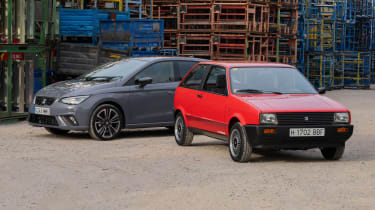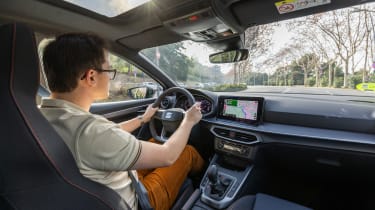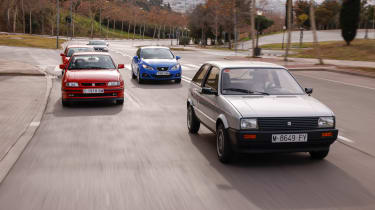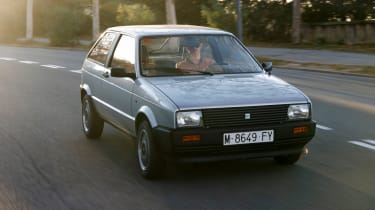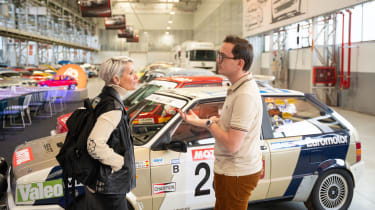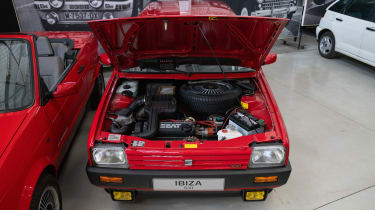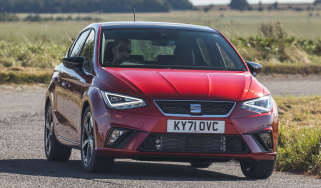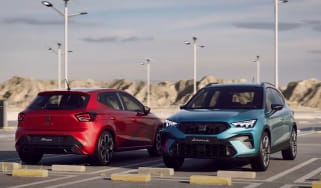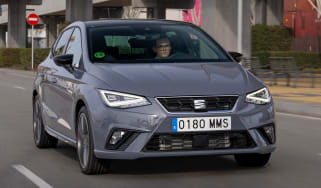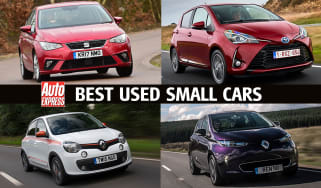SEAT Ibiza turns 40: our VIP invite to the big Ibiza birthday party
We head to the home of SEAT to celebrate the big-selling Ibiza supermini’s 40th birthday
It's not often that you get invited out to sunny Barcelona to drive a rare classic with a powertrain developed by Porsche and bodywork by ItalDesign – a company that’s now a maker of seven-figure hypercars.
But 2024 marks the 40th anniversary of the car in question, the original SEAT Ibiza. And although it’s not necessarily a model that will set motoring enthusiasts’ hearts racing, there’s no doubt that the Ibiza represents something of a landmark in the Spanish brand’s history.
When the marque was founded back in 1950, it first found its feet by selling rebadged versions of the Fiat 600 for its home market of Spain. However, this partnership with Fiat grew sour over the years, resulting in a messy court case that involved SEAT spray-painting one of its cars yellow in order to show which parts were different when compared with its Fiat Ritmo counterpart.
Despite the judges ruling in SEAT’s favour, the company needed a car entirely of its own design if it wanted any kind of success on the international stage. Cue the arrival of the Ibiza which, although commissioned by SEAT itself, was actually the result of the collaboration.
Porsche was drafted in by SEAT to develop the original Ibiza’s gearbox and 1.5-litre four-cylinder petrol engine. The latter produced exactly 84bhp, which was a pretty decent figure for the time, especially given that the Vauxhall
Nova GSi only produced around 15bhp more. For extra kudos, SEAT even paid Porsche seven German marks (about £2.50) per unit sold in order that it could use the ‘System Porsche’ name on the engine block.
With styling courtesy of ItalDesign – a firm responsible for some of the 20th Century’s most iconic cars, including the DMC DeLorean – the first SEAT Ibiza rolled off the production line in April 1984. Amazingly, that car still exists, taking pride of place in SEAT’s Heritage Collection warehouse. This historic model is still in factory-fresh condition, with its bright-red paintwork and cloth seats, and it also now features its unique chassis number printed on the windscreen.
While that car was deemed too special to leave the premises, SEAT has given us the keys to another example
in a virtually identical spec. Having spent a lot of time in the current-generation Ibiza, with its automatic gearbox and adaptive cruise control, getting behind the wheel of the original certainly highlights how far the Spanish supermini has come over the past four decades.
After the thrummy Porsche powertrain has spluttered into life, the first thing we notice is the original Ibiza’s lack of power steering; this was something added for the second-generation car (more on that later) – and while it certainly makes low speed manoeuvres a chore, it makes you, as the driver, feel almost directly connected to the front axle. That’s a sensation that simply can’t be replicated by the electrically assisted set-up of the current car.
The clutch bite point is pretty low, too, which means we are sometimes less-than-graceful when pulling away. However, the stand-out feature has to be the Mk1’s indicator stalk, or lack thereof. Instead of a traditional stalk, SEAT employed a rocker switch on a binnacle to the left of the steering wheel, which certainly takes a bit of getting used to and was unique even for its time.
While not an overnight success, sales of the SEAT Ibiza slowly picked up towards the end of the decade, with over 1.3 million first-generation models sold over the car’s lifetime. A hot SXi version was released in 1988, featuring a more potent 99bhp engine, but the Mk1’s final hurrah came in the form of the Ibiza Sport Line. This was powered by a 1.7-litre, 104bhp evolution of the SEAT System Porsche powertrain and can be seen as somewhat of a precursor to the first-ever Cupra model.
After being on sale for almost 10 years, the Mk1 Ibiza made way for the Mk2 in 1993. This was the second model to be produced – after the Toledo saloon – under full ownership by the Volkswagen Group, following the German giant’s acquisition of the SEAT brand in 1990.
Sharing parts with the VW Polo, the second-generation Ibiza was the first and only SEAT to get a high-performance variant with the illustrious GTI badge. Powered by a 2.0-litre four-cylinder unit producing 113bhp, the Ibiza GTI wasn’t quite as hardcore – nor as powerful – as a Ford Fiesta RS Turbo, but it did usher in a new era of SEAT’s involvement in motorsport, with the brand competing in the Spanish Gravel Cup, as well as, eventually, the World Rally Championship.
The basis for SEAT’s entry into the WRC came in the form of the even hotter Ibiza GTI 16v. Unlike the standard GTI, the 16v got a smaller 1.8-litre petrol, but thanks to a handful of mechanical upgrades, it produced a heftier 128bhp.
The result of this, which we find in our drive of an example from SEAT’s heritage fleet, was a car that felt much more purposeful than any Ibiza model that came before it. Stepping inside, we are greeted by ‘GTI 16v’ lettering embroidered on the seats, and we’re soon enthralled by the revvy nature of the car’s naturally aspirated powertrain. Furthermore, thanks to the addition of power steering, the second-generation Ibiza feels more eager to turn into corners. Our arms ache less after driving it, too.
Yet, perhaps the most influential aspect of the Ibiza Mk2 was how it became the genesis of the Cupra brand. While it’s now arguably even more relevant and far reaching than SEAT itself, Cupra found its origins after the Ibiza won the FIA 2.0-litre Rally Championship three years in a row.
To celebrate these victories, SEAT unveiled the Ibiza Cupra. Taking its name from an amalgamation of ‘Cup Racing’, the Cupra edition set itself apart from the rest of the Ibiza line-up through its 2.0-litre 16-valve engine, which produced 148bhp – the same as top-of-the-range versions of the modern, fifth-generation Ibiza. The Ibiza Cupra also got exclusive Kiwi-yellow paintwork, which was reminiscent of the first Ibiza Kit Car that competed in rallying.
Over the next few decades, the Ibiza went from strength to strength and through three more generations. We also manage to get behind the wheel of a Mk3 from 2004, as well as a Mk4 Ibiza from 2009 and the latest Anniversary Edition.
Driving each car one after the other truly showcases how far the Ibiza has come over its 40-year history. The Mk3 is the first car of the lot that feels truly ‘modern’, with its light steering and refined driving experience. Although surprisingly, even the Mk1 model we drive is equipped with electric windows – something that couldn’t be said for many small cars even a decade and a half ago.
In all that time, the Ibiza has not only become an icon for SEAT, but crucially, Spain itself. Today, cars are by far the country’s largest export, and the Ibiza being produced at SEAT’s factory in Martorell, Catalonia, has had a huge impact on that, as well as being the brand’s best-selling model.
During our time with SEAT, we catch up with the brand’s Global Head of Communications, Cécilia Taieb. She confesses that “even [we] always say that the ‘Ibiza’ brand is more important than SEAT – everybody knows the Ibiza.”
This, in a time where the future of SEAT is under scrutiny, is indicative of how the Ibiza is keeping the brand afloat. While you can now buy a Cupra Leon, as well as a Cupra Ateca, the only way to access the Ibiza ‘brand’ is via SEAT.
But the current, fifth-generation Ibiza has been on sale since 2017 and, despite a wide-reaching facelift in 2021 that introduced a handful of upgrades from across the VW Group, SEAT’s golden child is coming to the end of its shelf life. However, we’re yet to hear anything concrete from the company as to what the future holds for this iconic nameplate.
Thankfully, there’s a glimmer of hope as Taieb reassures us that we haven’t seen the last of the Ibiza. “You’ll see some news coming at the end of March,” she tells us. “The Ibiza’s still alive and kicking!”
So, just like Ibiza itself, the party never stops for SEAT’s strength and stay. If we’re to take Taieb’s word for it, we haven’t got too long to wait until we find out exactly what the company’s vision is for the future of the Ibiza. Regardless of what’s on the horizon, it’s clear that we – along with the whole of Spain – are intrigued to see how much further the Ibiza will have come in another 10 years, when it celebrates half a century of success.
A place in the sun
The Ibiza takes its name from the Spanish island famous for its banging nightlife, but it’s not the first SEAT to be christened after a location on the Iberian Peninsula.
The Ronda kicked things off in 1982 and since then we’ve seen the Ibiza, Malaga, Marbella, Toledo, Inca, Alhambra, Cordoba, Arosa, Leon, Altea, Ateca, Arona and Tarraco.
But how does SEAT decide which cities to name a car after? Cécilia Taieb says the priority is “finding somewhere that fits the character of the car”.
She also explains that it’s important to find somewhere that sounds “fun and sexy” in all languages; for example, the SEAT Malaga was the ‘Gredos’ in Greece, because the Spanish coastal city sounds like a rude Greek word.
We ask Taieb if a SEAT Benidorm could make an appearance: “Probably not!” she laughs, “We’ve never done a car that fits its character, but who knows!”
Will there be an electric SEAT Ibiza?
Currently there aren’t any electric SEATs, but did you know it once experimented with making a fully electric model? Back in 1992, Spain hosted the Olympic Games, and SEAT was asked to create a one-off pure-electric version of the Toledo saloon to open the marathon.
The later Ibiza Electrico shared the same powertrain, while 500kg of lead-acid batteries provided a range of around 31 miles – roughly the same as you’d get from a plug-in hybrid Cupra Leon. A 30bhp electric motor gave a top speed of 62mph, plus the car could be easily charged via a built-in two-pin cable housed in the grille.
While the Ibiza Electrico never went on sale, the arrival of an electric Volkswagen Polo in the next couple of years could cue the arrival of an Ibiza EV.
Which generation of Ibiza is your favourite? Tell us in the comments section below...


